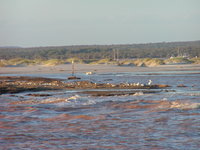Most of Marion’s study participants talked about having to survive racism, with some experiencing racism every day.
“Having experienced all those things and still surviving, but still being strong in my culture, strong in my beliefs, able to work, able to earn a good living and making a difference in my community. Yeah I have survived.“
 Every participant spoke of the need to survive. Most participants spoke of surviving racism. Some participants were exposed to all levels of racism every day and, whilst being interviewed, gave examples of how they managed to survive.
Every participant spoke of the need to survive. Most participants spoke of surviving racism. Some participants were exposed to all levels of racism every day and, whilst being interviewed, gave examples of how they managed to survive.
One female participant in her early 40s discussed a number of racial experiences she was exposed to during school and then when she was employed. She survived these experiences and stayed strong in her culture and beliefs which enabled her to make a difference in her community:
“Having experienced all those things and still surviving, but still being strong in my culture, strong in my beliefs, able to work, able to earn a good living and making a difference in my community. Yeah I have survived.“
When discussing her personal journey and resilience, a female participant in her 30s from Tasmania explained that survival was a strong characteristic of her resilience. It was the first resilient characteristic mentioned, showing how important survival was to her:
“Ok survival would have to be one of the first because you know well they (white authorities) tried to wipe us out and they even used to say there are no Aboriginals in Tasmania.“
One participant in her early 40s was adopted by a non-Aboriginal family at a young age. She explains her frustration with her family, about the racism she had to confront:
“My white family would always say ‘You’re just part of our family and we will always love you for the way you are’. So if the racism thing came up they would say oh that’s all rubbish or nonsense so it wasn’t real to them but it was real to me.“
It is interesting how this participant dealt with the racist taunts she received during and out of school. Not wanting to use ‘violence’, she used other strategies to deal with the racism that she was confronted with. One of her strategies was to deny her Aboriginality in order to survive.
On other occasions however, she identified as an Aboriginal but an Aboriginal with lots of cousins, threatening to get all her Aboriginal cousins to deal with certain children giving her a hard time:
“A couple of times I would deny that I was Aboriginal and told them that I was Jamaican and that totally confused some people because they didn’t know what a Jamaican was. I never would fight I just spoke with conviction and I put on this front that usually worked so I never had to fight.
I would also say that I had lots of cousins and I would threaten to get them for any kid who was giving me a hard time. So yeah I was either Jamaican or I had lots of cousins.
I was just a smart arse basically. I would always give them a mouthful and be sarcastic about it and then smile at them. Having a smart answer worked for me that’s what I did to survive. I would say something that baffled kids they didn’t know how to answer and were left feeling quite stupid.”
Every Aboriginal person interviewed had their own way of dealing with racism. For some, the only way was to use violence, so they lashed out in a physical way. While for others, not accustomed to violence or not wanting to physically fight, had their unique way of dealing with racism.
Whatever the case may be, each individual had to deal with racism. They could confront it and survive it, or they could succumb to it. All participants interviewed had confronted and survived racism.


